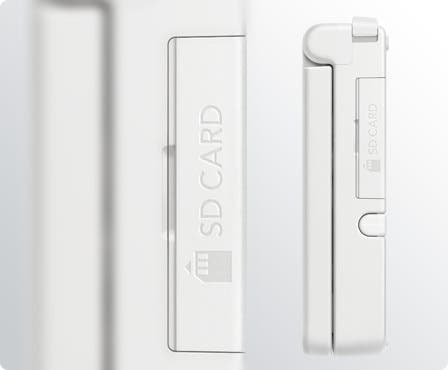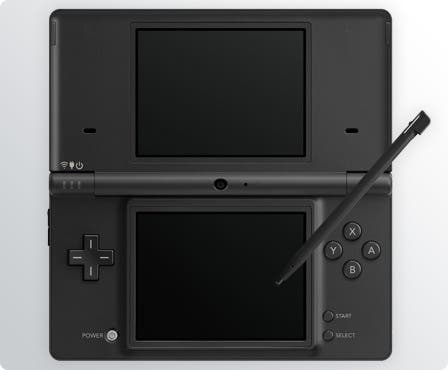Nintendo DSi
Bright young things.
Build quality is something we'd be daft to judge yet, but the unit's been robust enough to survive a week in my bag, the SD card slot where the DS Lite's power slider used to be is a sturdy flap that seems unlikely to come loose, and the cameras - one in the middle of the inside hinge next to the microphone, and one in the bottom-right corner on the outside of the top-screen - have no raised profile to snag anything.
It's also worth noting the AC adapter is also new. The voltage input is apparently 4.6 rather than 5.2, but the switcheroo is another inconvenience for anyone upgrading. If you're interested, the only other device that uses the same AC adapter is the Japan-only Nintendo Wi-Fi hub, as far as we can tell, so if you break yours, that'll be the thing to buy off eBay or YesAsia, since Nintendo doesn't seem to sell ACs separately.
Disappointingly for importers, switching on reveals all the menus are in Japanese, and there's no English language option hidden in the settings menu. The more expansive, Wii-style settings menus also reveal parental control settings and a system update option for acquiring new firmware. Network settings still appear to be WEP-only (boo, Nintendo), and the rest is consistent with the old DS functionality, albeit a bit more navigable than the weird slidey skyscraper system of old. (UPDATE: Upon closer inspection, it turns out that the DSi does support newer Wi-Fi security standards, including WPA and WPA2, via an advanced settings panel. Yay Nintendo!)
Away from the system menu, the dashboard is a row of horizontal icons that you can drag and scroll left and right using d-pad or stylus - a bit like the iPhone, really, except not so self-consciously smooth-scrolling - with icons for game card, camera, music player, DSi Shop, download play and PictoChat. The latter duo are lifts from the old OS (they haven't even updated the interfaces), so don't expect online Friends-list PictoChat or anything. At least neither requires you to switch off the DS when you're done with them.
Nintendo presumably also has the option to upgrade these - and add new features, as it has done with things like the voting, news and weather channels on the Wii - through the firmware updates, of which there's already been one. We also suspect that the firmware tweaks will be used to clamp down on the infamous R4 and other piracy devices.

As you probably know by now, the internets have noticed that the DSi doesn't load the R4 or any of its cousins, and it's no secret Nintendo would like to crush the devices. A Sony-style loophole-fixing approach to firmware, to stay ahead of the hackers, would make sense. (However, Nintendo might want to watch out for collateral damage. We often get development carts with review code on them, but they don't work on the DSi, and developers won't be happy to hear that.)
One unexpected bonus of the new DSi and its fancy new menu - to which you can return at a tap of the power button, as mentioned - is that you can now hot-swap game cards. In the old days, popping out a cartridge and replacing it with the power running was a recipe for minced battery backup save-games, but apparently it's all fine now, and in practice as soon as you insert a DS card it shows up on the menu. SD cards, poked in through the sturdily-flapped slot on the right, don't notify you once inserted, but you can see them highlighted for access in the photo and music apps.
There's a darker side to all this card support though, and that's region-locking for DSi-specific software. We don't know when this will occur, or to which games it will apply, but we can happily report that the European, US and Japanese DS games we tested all worked, and looked jolly nice on the new screen.

The one exception, of course, is Guitar Hero: On Tour, and that's because of the one really big thing left to discuss: the loss of the Game Boy Advance slot. It means that Guitar Hero's GBA-slot peripheral no longer fits, and it will be interesting to see how Activision responds. Or rather, it will be interesting if we ever find out that it already has. The European and US release timings for the DSi are still undecided, and we wouldn't be surprised if the success of On Tour and the impending launch of Guitar Hero: Decades had something to do with it.
As for why the GBA slot is gone, we can only assume there wasn't room in amongst all the other gizmos, because the unit's profile suggests it would physically fit. Or perhaps the GBA has withered beyond the point of lateral thinking.
Either way, the DSi is one to watch rather than import now. Whether it's worth replacing your DS Lite with further down the line will be a question of how much good stuff ends up on the DSi Shop, and how much developers get out of the camera with DSi-specific releases. In the meantime, it's another interesting, attractive piece of handheld hardware from Nintendo, that embodies traditions rediscovered and embraced in recent years while quietly sweeping up a few loose ends.
The Nintendo DSi is out now and Japan and will be released in Europe next year. Special thanks to friend-of-Eurogamer Jonti Davies for his help with translation.








